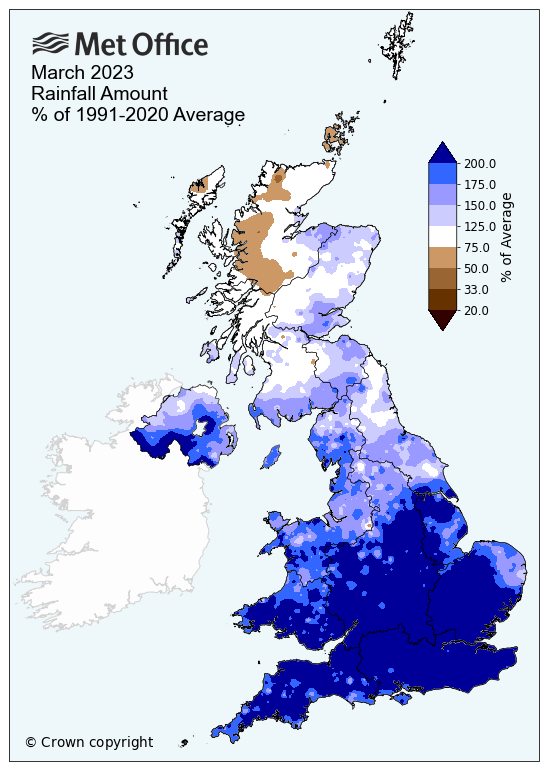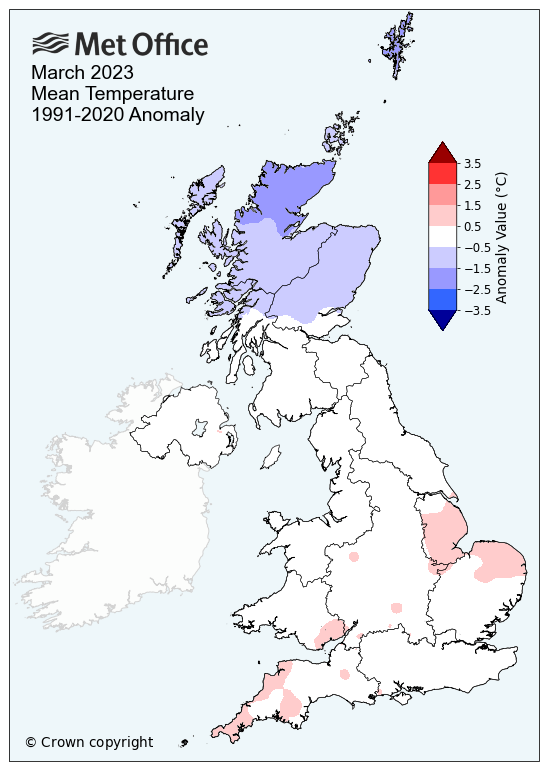Wettest March in over 40 years for England and Wales
Author: Press Office
14:29 (UTC+1) on Fri 31 Mar 2023
England and Wales had their respective wettest Marches since 1981, with Northern Ireland also seeing one of its wettest Marches on record.
This piece was updated on 3 April to reflect the full month’s provisional figures.
According to provisional Met Office statistics, England, Wales and Northern Ireland have all had one of their ten wettest Marches on records which go back to 1836.
- England’s wettest March since 1981 and the third wettest on record.
- Wales’s March was its wettest since 1981 and fifth wettest on record.
- Northern Ireland had its third wettest March, though it didn’t eclipse its wettest March on record, set in 2019.
A rain-filled month

In a rain-soaked month, Wales had 206.5mm of rain, double its long-term average. For England, 119.2mm of rain fell, which is more than double its long-term average, with 104% more rainfall than average.
Northern Ireland has seen 151.2mm of rain fall, which is 74% more than average.
Scotland, however, saw rainfall totals more in line with its average, with 130.1mm of rain being just 4% more than average.
The Met Office’s Dr Mark McCarthy is head of the National Climate Information Centre. He said: “Although the month started cold and dry for many, moist, milder air soon pushed up from the south bringing frequent heavy periods of rain, this being longest-lasting in the southern half of the UK.
“Overall this has been an unsettled month dominated by Atlantic low pressure weather systems. Many parts of southern and central England and south Wales have received more than double their average rainfall for March, which is in stark contrast to the dry February England experienced.”
Environment Agency Executive Director and National Drought Group chair John Leyland said: “Rainfall in March has helped water levels improve, but it follows on the heels of a very dry February so there is a need to remain vigilant – especially in areas that have not recovered from the drought last year.
“We cannot rely on the weather alone, which is why the Environment Agency, water companies and our partners are taking action to ensure water resources are in the best possible position both for the summer and for future droughts.
“As ever, it is important that we all continue to use water carefully to protect our precious rivers, lakes and groundwater, and the environment and wildlife that depend on it.”
A lack of March sunshine

The majority of the UK had a duller than average month in terms of sunshine hours, with only some counties in the northwest of Scotland seeing figures above their respective long-term averages.
Wales had its second dullest March on record in a series which goes back to 1910. Only 1936 had a duller March than the 64.3 hours of sunshine seen in 2023 for the area.
Several counties, including Devon, Somerset, Hampshire and Wiltshire had their dullest March on record as cloud made frequent incursions into the south and west.
According to provisional figures, the UK has seen 81.1 hours of sunshine, which is just 74% of the long-term average, though this masks regional variations. England had 75 hours (64% of average) and Northern Ireland has seen 85.3 hours of sunshine (84% of average).
In contrast, Scotland ends the month closer to average for sunshine, with its figure 94.6 hours (97% of average).
A month of two halves for temperature

March started cooler than average, with a northerly plunge of air bringing associated snow and ice for many. Across northern Scotland, lying snow cover resulted in some particularly low minima, with –16.0 C recorded at Altnaharra, Sutherland on 9 March, and daytime temperatures struggling to rise above freezing.
Further south, a mild second half of the month brought temperatures back more in line with long-term averages. England, Wales and Northern Ireland all close the month close to their average temperature for the month. Scotland, however, has been cooler than average.
Dr Mark McCarthy concluded: “March 2023 will be remembered for being a dull and wet month, especially for those in the south of the UK. While the rainfall has been notable in England and Wales, it hasn’t been enough to fully recover the deficit of rain over the last 12 months. People will also look back on the snow that arrived mainly for northern areas, but, while disruptive for some, this was a fairly typical snow event for the UK in March.”
This piece was updated on 3 April to reflect the full month’s provisional figures.
Provisional March 2023 statistics
| Maximum temp | Minimum temp | Mean temp | Rainfall | Sunshine | ||||||
|---|---|---|---|---|---|---|---|---|---|---|
| Area | Actual temp (°C) | Anomaly (°c) | Actual temp (°C) | Anomaly (°C) | Actual temp (°C) | Anomaly (°C) | Actual (mm) | Anomaly (%) | Actual (hours) | Anomaly (%) |
| UK | 8.9 | -0.3 | 2.4 | 0.2 | 5.7 | 0.0 | 132.0 | 155 | 81.1 | 74 |
| England | 10.0 | -0.2 | 3.5 | 0.8 | 6.8 | 0.3 | 119.2 | 204 | 75.0 | 64 |
| Wales | 8.9 | -0.4 | 3.5 | 1.0 | 6.2 | 0.3 | 206.5 | 200 | 64.3 | 59 |
| Scotland | 7.1 | -0.6 | 0.2 | -1.0 | 3.6 | -0.8 | 130.1 | 104 | 94.6 | 97 |
|
N. Ireland |
9.9 | 0.3 | 2.6 | 0.2 | 6.3 | 0.3 | 151.2 | 174 | 85.3 | 84 |
Updated at 10:44 (UTC+1) on Mon 3 Apr 2023





